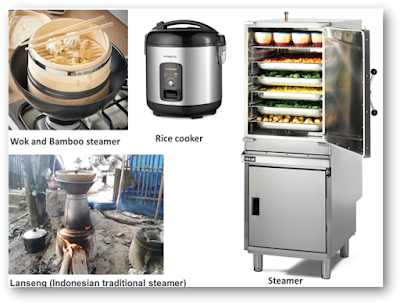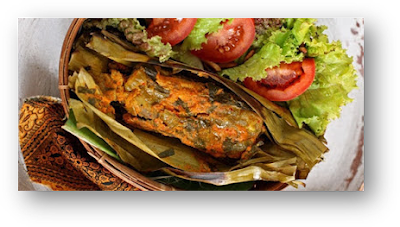Cooking Method: Steaming
What is Steaming?
- Steaming is a method of cooking using steam.
- The temperature at +212 °F /100 °C
- Gentle vapor bath, Minimize item never in direct contact with liquid
- Covered tightly during cooking
- Delicate flavor and texture
- Sauces made separately
 |
| Steaming Method |
Characteristics of items to be steamed
- Naturally tender cuts of meats and fish
- Foods suitable for steaming: Chicken or game birds, fish, shellfish, fruits, and vegetables
- Steaming wrappers: Cabbage, seaweed, corn husk, leek, banana leaf, plastic-wrapped, etc.
 |
| Types of Wrappers |
Equipment
 |
| Steaming Equipment |
Steaming Method
- Bring liquid to a boil or preheat the steamer
- Add the main item to a steamer and arrange it on a rack in a single layer
- Cover steamer
- Steam food to the desired degree of doneness
- Serve food immediately with appropriate sauce and garnish
 |
| Steamed Seasonal Vegetables |
En papillote
What is en papillote?
- Variation of steaming
- En papillote in French means "in parchment" or “In the paper”, or al cartoccio in Italian, or Pepes in Indonesian cuisine is a cooking method that food should be wrapped in wrapping material before steaming or baking
- Main item and accompaniments cooked in steam from natural juices
- This method is frequently employed for cooking fish and involves enclosing the food in a pouch of parchment paper or other wrapping material along with a little liquid (often wine) and perhaps lemon, herbs, and even thinly sliced vegetables.
- Characteristics of item to be steamed, naturally tender cut of fish or chicken.
 |
| Fish en Papillote |
En papillote Method - Step by Step
- Cut parchment into heart shape large enough to hold food in half
- Lightly oil or butter wrapper to prevent burning
- Arrange vegetables, aromatics, or sauce on half of the wrapper; top with the main item
- Fold another half over
- Crimp edges to tightly secure
- Place package on preheated baking sheet
- Bake in a moderate oven until the package is crisp and lightly browned (in steam from natural juices).
 |
| Pepes Ikan (Indonesia Fish en Papillote) |
Read: 5 Types of Thick Soup in Culinary Knowledge
Previous: Blanching,
Next: Poaching,
Culinary Training Program,
AMAZON Chef's Collection,
PDF Presentation,
Steaming Method Benefit in Cooking
- Compared to most other cooking methods, steaming preserves up to 50 percent more nutrients in the foods
- Lower Cholesterol
- Steaming has an advantage over methods such as boiling or even simmering in that there is no agitation involved, so it's gentler on delicate items like seafood. And because it doesn't require the food to be submerged, it avoids the loss of nutrients through leaching. It also cooks relatively quickly.
- Preserves the fiber, color, and flavor of vegetables
- Time: Depending on what you’re cooking, steaming can be a quick way to cook a handful of greens or a gentle way to cook pudding or dumplings.
- Taste and Flavor: No cross flavors, one of the surest ways to experience the purest flavor of the food you cook is to steam it.
- Texture: With steaming, food is left moist and tender. Because the cooking liquid never touches the food. This means food retains its shape, color, and texture.
- Nutrition: No oil is needed to steam, plus nutrients don’t leach out into the water, so the vitamins and minerals are retained.
Share our Links
Sitemap,Previous: Blanching,
Next: Poaching,
Culinary Training Program,
AMAZON Chef's Collection,
PDF Presentation,
Great blog learned many things about fitness from this blog, very informative.
ReplyDeleteAyurvedic Clinic In Chennai
Panchakarma Treatment In Chennai
Ayurvedic Centre In Chennai
Ayurvedic Medicine In Chennai
Panchakarma In Chennai